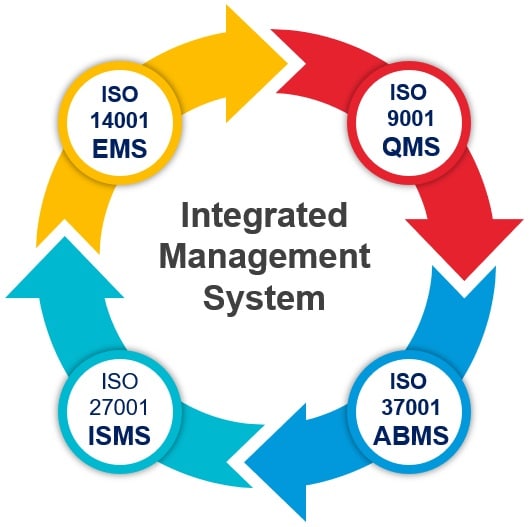Integrating multiple ISO management systems, such as ISO 9001 (Quality Management System), ISO 14001 (Environmental Management System), ISO 27001 (Information Security Management System), and ISO 37001 (Anti-Bribery Management System), can be a complex yet rewarding endeavor. Here’s a comprehensive guide on how to approach this integration effectively:
Initial Assessment and Planning
Understand the requirements and scope of each ISO standard. Determine the common elements among the standards and identify areas where integration can occur. Develop a comprehensive plan outlining the integration process, timeline, responsibilities, and expected outcomes.
Leadership Commitment
Gain commitment from top management to support and resource the integration effort. Emphasize the value of an integrated approach in promoting efficiency, risk management, and ethical behavior across the organization.
Cross-Functional Team
Assemble a cross-functional team with representatives from relevant departments to ensure a comprehensive understanding of the standards and a collaborative approach to integration.
Gap Analysis
Conduct a thorough gap analysis for each ISO standard to identify the existing processes and procedures that align with the requirements. Determine the overlaps and gaps that need to be addressed in the integrated system.
Integrated Policy and Objectives
Develop an integrated policy statement that reflects the organization’s commitment to quality, environmental sustainability, information security, and anti-bribery practices. Establish integrated objectives that align with the organization’s strategic goals and cover all four areas.
Risk Assessment and Management
Perform a holistic risk assessment covering quality, environmental, information security, and anti-bribery risks. Identify common risks and opportunities across the different areas and develop a comprehensive risk management strategy.
Process Integration
Identify opportunities for process alignment and integration. Focus on shared processes like document control, employee training, and internal auditing, and ensure that they meet the requirements of all relevant standards.
Documentation Integration
Develop an integrated documentation system that covers the requirements of all four standards. This includes manuals, procedures, work instructions, and forms. Keep the documentation accessible, clear, and coherent.
Performance Measurement
Establish integrated key performance indicators (KPIs) that measure progress across all four management areas. Regularly monitor and report on these KPIs to track the organization’s performance.
Training and Awareness
Provide comprehensive training to employees on the integrated system, emphasizing their roles in maintaining quality, environmental sustainability, information security, and ethical behavior. Raise awareness about the benefits of integration and ethical practices.
Internal Auditing
Conduct integrated internal audits that evaluate compliance with all four standards. Use a risk-based approach to identify areas for improvement and ensure continuous compliance.
Management Review
Integrate management review processes to evaluate the performance of the integrated system. Review progress toward objectives, identify areas for improvement, and make necessary adjustments.
Continual Improvement
Foster a culture of continual improvement across all management areas. Encourage employees to contribute ideas for enhancing processes, minimizing environmental impact, securing information, and preventing bribery.
Certification and External Audit
Seek certification for the integrated system from recognized certification bodies. Prepare for external audits that assess compliance with ISO 9001, ISO 14001, ISO 27001, and ISO 37001 standards.
Communication and Reporting
Maintain transparent communication with stakeholders about the organization’s integrated approach. Regularly report progress, achievements, and improvements in all four management areas.
Technology and Tools
Leverage technology, such as integrated management system software, to streamline processes, track performance, and ensure effective communication among different management areas.
Conclusion
The specifics of integrating the QMS, ISMS, ABMS and EMS will depend on the nature of your organization, its size, industry, and existing processes. Customizing the integration process to fit your organization’s needs and goals is essential for a successful outcome. It’s also a good practice to stay updated with any revisions or changes to the ISO standards.

